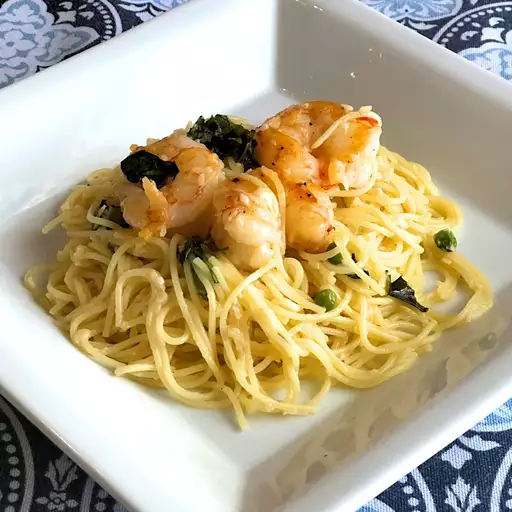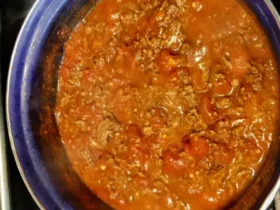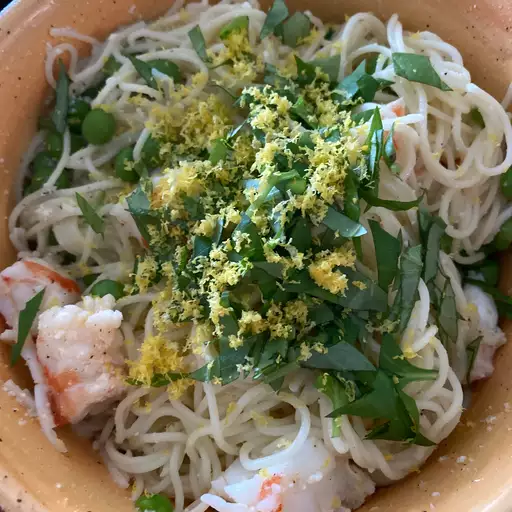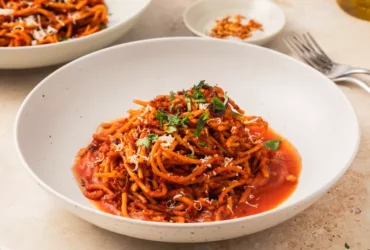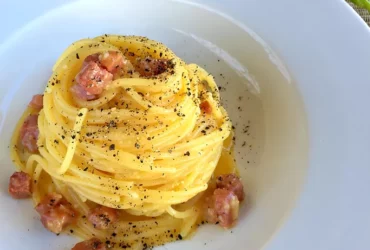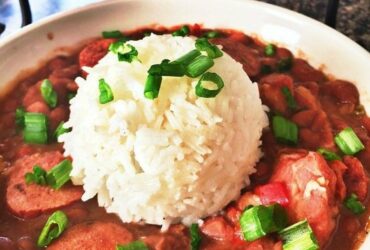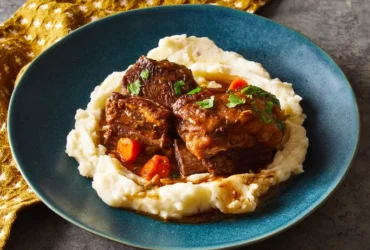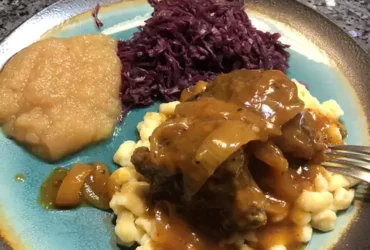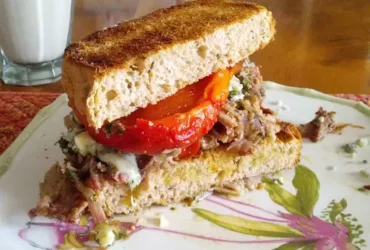Ingredients
Essential Components
The success of a dish like last-minute lemon shrimp pasta recipe heavily relies on the selection and quality of its ingredients.
Here are some essential components to consider when preparing this recipe:
Main Ingredients:
- Pasta: Fettuccine or spaghetti work well for this dish, but any flat pasta would do. Choose a high-quality pasta that cooks al dente.
- Shrimp: Fresh and sustainably sourced shrimp is a must. You can use any type of shrimp you prefer, such as tiger prawns, whiteleg shrimp or spot shrimp.
Flavor Enhancers:
- Lemon juice: Freshly squeezed lemon juice is a key component in this recipe. Choose organic lemons to avoid any chemicals and artificial preservatives.
- Garlic: Fresh garlic adds depth to the dish. Use high-quality, organic garlic for the best flavor.
- Herbs: Chopped parsley or basil add a fresh and fragrant flavor to the pasta.
Pantry Staples:
- Olive oil: A good quality olive oil is essential for cooking and adding flavor to the dish. Choose an extra virgin or cold-pressed olive oil for the best taste.
- Butter: Unsalted butter adds richness and creaminess to the pasta sauce.
Optional Ingredients:
- Cream or heavy cream: Adding a splash of cream can make the sauce more indulgent and creamy.
- Grated Parmesan cheese: A sprinkle of grated Parmesan cheese adds a salty and nutty flavor to the dish.
The ingredients used in this last-minute lemon shrimp pasta recipe are:
- 12 oz (340g) pasta of your choice, such as spaghetti or linguine
- 2 tablespoons olive oil
- 1 pound (450g) large shrimp, peeled and deveined
- 4 cloves garlic, minced
- 2 lemons, juiced and zested
- 1/4 cup white wine (optional)
- 1 tablespoon unsalted butter
- Salt and pepper to taste
- Grated Parmesan cheese for serving (optional)
The pantry staples required for this recipe include:
- Fresh parsley or basil leaves for garnish
- Salt and pepper
- Olive oil
- White wine (optional)
- Unsalted butter
You can also use some of your favorite seasonings or herbs to give the dish a personal touch, such as:
- Lemon zest for extra citrus flavor
- Chopped fresh herbs like parsley, basil, or dill
- Freshly ground black pepper for added depth
In terms of specific ingredients that are not included in this list but can be used to enhance the dish, some options include:
- Red pepper flakes for a spicy kick
- Capers or chopped fresh chives for a salty and oniony flavor
- Fennel seeds or grated carrot for added freshness and crunch
Please note that these ingredients are optional and can be adjusted to taste.
12 oz (340g) linguine pasta
Linguine pasta is a long, flat, and narrow type of Italian pasta made from durum wheat semolina. It is typically 10 to 12 inches (25 to 30 cm) in length and has a smooth surface. The shape of linguine is ideal for pairing with light, oily sauces that cling to the pasta, such as olive oil, butter, or pesto.
In this recipe, we will be using 12 oz (340g) of linguine pasta, which should yield approximately 4 servings. You can adjust the amount of pasta according to your needs and the number of people you are serving.
Linguine is a versatile pasta shape that works well with both vegetarian and seafood-based sauces. Its long shape also makes it easy to twirl around a fork when eating. The smooth surface of linguine helps sauce adhere evenly, making each bite flavorful and satisfying.
The texture of linguine is slightly firm, which provides a good balance between the softness of some other pasta shapes and the crunchiness of others. This texture also makes it easy to pair with a variety of ingredients, from vegetables to proteins like shrimp or chicken.
1 lb (450g) large shrimp, peeled and deveined
To make this delicious Last-Minute Lemon Shrimp Pasta Recipe, you’ll need a few high-quality ingredients, with a focus on fresh and flavorful components.
The star of the show is, of course, 1 lb (450g) large shrimp, peeled and deveined. This means that the shrimp have been removed from their shells and had their veins and guts taken out as well.
The quality of your shrimp will greatly impact the flavor and texture of this dish. Look for fresh, firm shrimp with no visible signs of damage or bruising.
It’s also worth noting that the size of the shrimp can vary depending on what you have access to in your local market. However, large shrimp are generally preferred for this recipe because they provide a nice balance of flavor and texture when cooked.
In addition to the shrimp, you’ll need some other essential ingredients to make this recipe shine. These include:
- 12 oz (340g) pasta of your choice (such as spaghetti or linguine)
- 2 tablespoons (30g) unsalted butter
- 2 cloves garlic, minced
- 1/4 cup (60g) freshly squeezed lemon juice
- 1 tablespoon (15g) olive oil
- Salt and pepper to taste
- Fresh parsley or dill for garnish (optional)
2 lemons, juiced
The key to a tangy and bright Last-Minute Lemon Shrimp Pasta recipe lies in the flavorful ingredients, particularly the 2 lemons that are juiced.
When it comes to squeezing those lemons, make sure to get as much juice as possible from each one. You can use a manual or electric juicer, or even simply squeeze them with your hands over a fine-mesh strainer to catch any seeds or pulp.
The resulting lemon juice should be clear and free of any sediment, with a slightly acidic taste that will help balance out the richness of the shrimp and pasta.
Use 2 lemons for this recipe because the acidity from both lemons is necessary to cut through the oiliness of the garlic and create a harmonious flavor profile.
A good rule of thumb when juicing lemons is to squeeze them just before using, as the juice will lose its potency if left to sit for too long. In this recipe, the lemon juice adds an immediate burst of citrus flavor that complements the other ingredients perfectly.
4 cloves garlic, minced
The success of this recipe lies in its use of a medley of ingredients, each one carefully selected to enhance the flavors and textures of the dish.
At the heart of it all are four cloves of garlic, minced to bring out their potent flavor and aroma. The pungency of garlic is an essential component in many dishes, and its use here serves to complement the delicate taste of the lemon and the succulence of the shrimp.
The garlic, once minced, adds depth and richness to the dish when it’s sautéed with some olive oil. The smokiness of the oil infuses into the garlic, elevating its flavor even further. This mixture is then mixed in with the cooked pasta, which has been tossed with lemon juice, chopped parsley, and grated parmesan cheese.
The acidity from the lemon perfectly balances out the creaminess of the parmesan and the richness of the garlic-infused olive oil, creating a delightful harmony on the palate. Meanwhile, the shrimp adds protein and texture, making each bite feel more substantial.
So, what are the key ingredients in this recipe? In addition to the four minced cloves of garlic, we also have:
- Lemons: their juice adds brightness and acidity to the dish
- Parsley: adds a pop of color and freshness
- Shrimp: provides protein and texture
- Parmesan cheese: adds creaminess and richness
1/4 cup (15g) chopped fresh parsley
When it comes to the ingredients for this quick and delicious Last-Minute Lemon Shrimp Pasta Recipe, one key component is 1/4 cup (15g) of chopped fresh parsley.
Chopped fresh parsley adds a burst of freshness and fragrance to the dish, balancing out the rich flavors of the shrimp and lemon. The bright green color also adds a pop of vibrancy to the presentation of the pasta.
The 1/4 cup measurement is equivalent to about a small handful of chopped parsley leaves. To chop the parsley, simply place it on a cutting board and cut off the stems, then mince or chop the leaves into fine pieces using a sharp knife.
It’s worth noting that you can also use curly-leaf parsley instead of flat-leaf parsley for this recipe, but keep in mind that curly-leaf will have a slightly different texture and flavor profile. If using curly-leaf, simply chop it up as finely as possible to release its oils and flavors.
The 15g weight measurement is a good way to ensure you’re using the right amount of parsley for this recipe. To measure by weight, place a small bowl or container on your kitchen scale and zero out the weight, then add the chopped parsley until it reaches the desired weight of 15g.
Overall, the 1/4 cup (15g) of chopped fresh parsley is an essential component of this Last-Minute Lemon Shrimp Pasta Recipe, adding freshness, flavor, and visual appeal to the dish.
Salt and pepper to taste
When it comes to cooking a delicious and flavorful last-minute lemon shrimp pasta, the quality of the ingredients can make all the difference.
The first ingredient that plays a crucial role in this recipe is the salt. Salt adds flavor, texture, and helps bring out the natural flavors of other ingredients. However, using too much salt can overpower the dish, so it’s essential to use it judiciously.
Salt: A Guide to Using It Correctly
Here are some tips on how to use salt effectively:
- Add a small amount of salt to your pasta water as it cooks. This helps season the pasta evenly and gives it a subtle flavor.
- Use high-quality salt, such as sea salt or kosher salt, which have a more nuanced flavor than regular table salt.
The next ingredient that’s essential to this recipe is pepper. Like salt, pepper adds depth and complexity to the dish, but using too much can be overpowering.
Pepper: A Guide to Using It Correctly
Here are some tips on how to use pepper effectively:
- Add a small amount of freshly ground black pepper to your pasta just before serving. This helps preserve the aroma and flavor of the pepper.
- Use peppercorns instead of pre-ground pepper for a more intense flavor. Simply grind them in a pepper mill or mortar and pestle just before using.
In terms of quantity, it’s essential to remember that salt and pepper should be used “to taste.” This means adding small amounts until the desired level of flavor is achieved.
Why Use Salt and Pepper in the Right Amount?
Using too much salt or pepper can ruin a dish by overpowering its natural flavors. On the other hand, using too little may result in an underwhelming taste experience.
The key to getting it right is to balance the flavor of your lemon shrimp pasta with a delicate seasoning of salt and pepper. By doing so, you’ll create a dish that’s both flavorful and visually appealing.
Conclusion
In summary, salt and pepper are two essential ingredients in any last-minute lemon shrimp pasta recipe. Using them correctly can elevate the flavor and texture of your dish, while using too much can ruin it.
By following these tips on how to use salt and pepper effectively, you’ll be able to create a delicious and memorable meal that’s sure to impress even the most discerning palates.
Olive oil for cooking
Olive oil is a fundamental ingredient in cooking, and it’s essential to choose the right type for your dish. In this recipe, we’ll be using olive oil for its distinct flavor and health benefits.
Why Olive Oil?
Olive oil is an excellent choice for cooking because of its high smoke point, which allows it to withstand high temperatures without breaking down or smoking. This makes it ideal for sautéing, roasting, and frying.
Taste and Flavor
The unique taste and flavor of olive oil enhance the overall dish. With a fruity, peppery, or nutty flavor profile depending on the variety, olive oil adds depth to your Last-Minute Lemon Shrimp Pasta recipe.
Benefits of Olive Oil for Cooking
- Polyphenols and antioxidants in olive oil help protect against cell damage and inflammation
- Moderate consumption may contribute to heart health by reducing cholesterol levels
- Olive oil contains healthy fats essential for brain function, hormone regulation, and nutrient absorption
Selecting the Right Olive Oil for Your Recipe
When choosing olive oil, consider the flavor profile you desire and the acidity level. For cooking, a mild or medium-flavored olive oil is best. Some popular varieties include:
- Kalami
- Arbequina
- Picholine
- Haas
Storage and Shelf Life
To maintain the quality of your olive oil, store it in a cool, dark place away from heat sources. Olive oil generally has a shelf life of one to two years. If you notice a decrease in flavor or an off smell, it’s best to discard the oil.
The key to making a delicious Last-Minute Lemon Shrimp Pasta Recipe lies in selecting the right ingredients. You’ll need some basic pantry staples, fresh produce, and high-quality seafood to bring this dish together.
For the pasta, you can use any type of long, thin shape you prefer, such as spaghetti or linguine. Make sure to choose a 100% durum wheat pasta for the best flavor and texture.
In addition to the pasta, you’ll need some unsalted butter and a high-quality olive oil for cooking. A mild-flavored garlic, freshly minced or pressed is also essential for adding depth of flavor.
For the seafood component, you can’t go wrong with succulent shrimp. Choose fresh or frozen shrimp that has been previously thawed and peeled, leaving only the tails intact.
You’ll also need some fresh lemon juice, preferably from a recently squeezed lemon for the best flavor. A pinch of salt is necessary to balance out the dish, but be mindful not to add too much as it can overpower the other flavors.
Other ingredients you may want to consider adding include some chopped parsley or basil for added freshness and a sprinkle of parmesan cheese for an extra burst of flavor. If you’re feeling adventurous, you could also try adding some sliced sun-dried tomatoes or a sprinkle of red pepper flakes to give your dish a spicy kick.
Remember, the key to making this recipe in just minutes is to have all your ingredients prepared and within reach before starting to cook. This way, you can quickly sauté the shrimp and garlic, add in the pasta, and finish with a drizzle of lemon juice and olive oil for a dish that’s both delicious and visually appealing.
Cooking Methods
Step-by-Step Preparation
To prepare a delicious and quick Last-Minute Lemon Shrimp Pasta dish, it’s essential to understand various cooking methods and step-by-step preparation techniques.
Cooking methods refer to the ways in which food is prepared for consumption. Common cooking methods include boiling, steaming, frying, grilling, roasting, sautéing, and baking. Each method has its unique advantages and disadvantages.
For instance, boiling is a simple and inexpensive way to cook pasta, but it can result in a softer texture that may not be ideal for some dishes. On the other hand, sautéing is a faster method that requires minimal oil, making it perfect for quickly cooking shrimp and vegetables while preserving their nutrients.
Step-by-step preparation involves breaking down complex recipes into manageable tasks that can be completed in sequence. This technique helps ensure consistency and accuracy in cooking.
In the context of the Last-Minute Lemon Shrimp Pasta Recipe, step-by-step preparation might involve the following tasks:
- Preparation of ingredients: Gather all necessary ingredients, including spaghetti, shrimp, lemon juice, olive oil, garlic, parsley, salt, and pepper.
- Cooking pasta: Boil a large pot of salted water and cook the spaghetti according to package instructions until it’s al dente.
- Preparing the sauce: In a separate pan, heat some olive oil over medium heat. Add minced garlic and sauté for 1-2 minutes until fragrant.
- Cooking shrimp: Add peeled and deveined shrimp to the pan with garlic and cook for 2-3 minutes per side, until they’re pink and cooked through.
- Assembling the dish: Combine cooked spaghetti, lemon juice, chopped parsley, and sautéed shrimp in a large serving bowl or individual plates.
- Seasoning: Add salt and pepper to taste, and serve immediately while hot.
This step-by-step approach ensures that even with limited cooking experience, one can still prepare a delicious Last-Minute Lemon Shrimp Pasta dish that’s both flavorful and visually appealing.
Cooking methods play a crucial role in bringing out the flavors and textures of ingredients, especially in a dish like last-minute lemon shrimp pasta.
There are several cooking methods that can be employed to prepare this recipe, each with its own unique characteristics and benefits:
Boiling
- Boiling is a common cooking method where food is submerged in liquid (in this case, water or broth) and heated until it reaches a rolling boil.
- This method is ideal for cooking pasta, as it helps to cook the noodles evenly and quickly.
Steaming
- Steaming is a moist-heat cooking method where food is cooked in steam rather than direct heat.
- This method is great for delicate ingredients like seafood, as it helps to preserve their moisture and flavor.
Searing
- Searing is a dry-heat cooking method where food is cooked quickly over high heat to create a crispy exterior and a tender interior.
- This method is perfect for cooking shrimp, as it helps to lock in the flavors and textures of the seafood.
Sauteing
- Sauteing is a dry-heat cooking method where food is cooked quickly over medium-high heat with some oil or butter.
- This method is ideal for cooking aromatics like garlic, onions, and ginger, as it helps to bring out their flavors and textures.
Grilling
- Grilling is a dry-heat cooking method where food is cooked over direct heat using a grill or grill pan.
- This method adds a smoky flavor to the dish and can be used for cooking ingredients like shrimp and vegetables.
Cooking Methods in Last-Minute Lemon Shrimp Pasta
- In this recipe, you will need to employ a combination of boiling and sauteing cooking methods to prepare the pasta and seafood.
- First, cook the pasta according to package instructions by boiling it in water until it reaches an al dente texture.
- While the pasta is cooking, heat some oil or butter in a pan over medium-high heat and add the garlic, onions, and ginger.
Saute the aromatics for 1-2 minutes until they are fragrant and softened, then add the shrimp to the pan and cook for an additional 2-3 minutes until pink and cooked through.
Finally, add the lemon juice, zest, and cooked pasta to the pan and toss everything together to combine.
Tips and Variations
- Use fresh and high-quality ingredients to get the best flavors and textures out of your dish.
- Add some red pepper flakes or hot sauce to give the dish a spicy kick.
- Try using different types of pasta, such as spaghetti or linguine, for a change of pace.
- Experiment with other seafood options, like scallops or mussels, for added variety.
Bring a large pot of salted water to a boil and cook linguine according to the package instructions until al dente. Reserve 1 cup (240 ml) pasta water before draining.
Cooking methods can greatly impact the final flavor and texture of a dish, and when it comes to cooking pasta for your last-minute lemon shrimp recipe, understanding various cooking techniques is essential.
There are several cooking methods that can be used to prepare linguine for this recipe:
- Steaming
- Boiling
- Sauteing
- Poaching
For this recipe, we’ll be using the boiling method to cook our linguine.
To begin, bring a large pot of salted water to a boil. The recommended ratio for salt is about 1 tablespoon per pound of pasta.
Once your water is boiling, add in your linguine and ensure it’s fully submerged under the water.
Cooking times will vary depending on the type of pasta you’re using, so be sure to check the package instructions. As a general guideline, linguine usually takes around 8-10 minutes to cook until al dente.
Al dente is a term that refers to the texture of cooked pasta when it still retains some firmness in the center and has a slightly crunchy bite.
To ensure you get the perfect al dente texture, check your pasta frequently during cooking. You can do this by biting into a piece or using a fork to test its doneness.
Once your linguine is cooked, reserve about 1 cup (240 ml) of pasta water before draining it. This reserved water will be used in the recipe later on to add moisture and create a rich sauce.
After draining the linguine, it’s ready to use for our lemon shrimp recipe!
In a large skillet, heat some olive oil over mediumhigh heat. Add the garlic and sauté for 12 minutes or until fragrant.
Cooking methods can vary depending on the desired texture, flavor, and appearance of the final dish. For a last-minute lemon shrimp pasta recipe, several cooking methods can be employed to achieve a quick and flavorful meal.
Pan-Searing Method
This method is ideal for cooking proteins like shrimp, scallops, or chicken quickly. To pan-sear ingredients, heat a large skillet over medium-high heat, add some olive oil, and cook the protein until browned on one side, about 2-3 minutes per side.
- Use a large skillet to sear multiple ingredients at once.
- Pan-searing is best suited for proteins that have a high moisture content and are relatively thin in thickness.
Stir-Frying Method
This method is commonly used for stir-fry dishes and involves quickly cooking ingredients over high heat. To stir-fry, heat oil in a wok or large skillet over high heat, add aromatics like garlic and ginger, then add the protein and cook until it’s almost done before adding other vegetables.
- Use a wok or large skillet with non-stick coating to prevent ingredients from sticking.
- Stir-frying is ideal for cooking ingredients quickly without losing their texture and nutrients.
Roasting Method
This method is perfect for cooking vegetables, meat, or fish evenly. To roast ingredients, preheat the oven to a desired temperature, place the ingredients on a baking sheet lined with parchment paper, drizzle with oil, and season with salt and pepper.
- Roasting brings out the natural flavors of ingredients without adding extra seasonings.
- Use a meat thermometer to ensure that roasted ingredients are cooked to a safe internal temperature.
Grilling Method
This method is suitable for cooking proteins and vegetables over an open flame or on a grill pan. To grill, preheat the grill to a medium-high heat, brush the protein with oil, season with salt and pepper, and cook until it’s browned and cooked through.
- Grilling adds a smoky flavor to ingredients without adding extra seasonings.
- Use a grill mat or parchment paper to prevent ingredients from sticking to the grill pan.
The last-minute lemon shrimp pasta recipe combines elements of all these cooking methods, using pan-searing to cook the shrimp and stir-frying to quickly sauté other vegetables. By understanding different cooking methods and choosing the right one for each ingredient, you can create a delicious and balanced meal in no time.
Add the shrimp to the skillet and cook for about 23 minutes per side, or until they turn pink and are cooked through.
Cooking methods refer to the various techniques used to prepare food, including high heat cooking, low heat cooking, and dry-heat cooking methods. The chosen method often depends on the type of ingredient being cooked, as well as personal preference and cultural tradition.
For example, in the context of the Last-Minute Lemon Shrimp Pasta Recipe, high-heat cooking is used to quickly cook the shrimp. This involves adding a small amount of oil or butter to a skillet over medium-high heat, then adding the shrimp once it has reached its smoking point. The shrimp should be cooked for about 2-3 minutes per side, depending on their size and thickness.
Low-heat cooking methods, such as steaming and poaching, are often used when delicate ingredients need to be cooked gently. This method involves placing the ingredient in a heat-proof container or steamer basket over boiling water, then covering it with a lid. The low heat helps to cook the ingredient evenly and prevents it from becoming tough or rubbery.
Dry-heat cooking methods include grilling and sautéing, which involve cooking ingredients over direct heat. Grilling typically involves placing the ingredient directly on a hot grill, while sautéing involves quickly cooking the ingredient in a pan with a small amount of oil. These methods are often used to add texture and flavor to food, as well as to create a crispy exterior.
Other cooking methods include braising, which involves cooking ingredients in liquid over low heat for an extended period of time. This method is often used for tough or fibrous ingredients that need to be broken down before they can be eaten. It’s also possible to use a combination of different cooking methods to achieve the desired result.
In the case of the Last-Minute Lemon Shrimp Pasta Recipe, it seems like there might have been an error in the instructions. Cooking shrimp for about 23 minutes per side is extremely long and would likely result in overcooked or burnt shrimp. A more typical cooking time for shrimp would be around 2-3 minutes per side, depending on their size and thickness.
Remove the shrimp from the skillet and set aside.
To complete this quick and easy Last-Minute Lemon Shrimp Pasta Recipe, it’s essential to understand various cooking methods that allow you to prepare each component efficiently.
For the shrimp, which will be cooked in a skillet, the primary method employed is sautéing. This technique involves quickly cooking the ingredients over medium-high heat while constantly stirring them to prevent burning or sticking to the pan. By removing the shrimp from the skillet and setting aside once they’re cooked through, you create space for the next ingredient – typically garlic – to be added and sautéed until fragrant.
Once the garlic is softened, you might add aromatics like onion or shallots, which are cooked until they’re translucent. This step enhances the flavor profile of your dish without overpowering it with strong spices or herbs early on. After that, you would generally add a sauce to bring everything together. In this case, it’s likely to be a simple and light lemon butter sauce.
After adding the pasta, the cooking liquid – usually water or a combination of stock and cream – is brought to a simmer, and then the heat is turned down to medium-low. The pasta cooks through while infusing with the flavors present in the skillet. By this stage, it’s time for the final touches: adding lemon juice, grated parmesan cheese, and any other finishing elements like chopped parsley. These components tie everything together by providing a nice balance of acidity, richness, and freshness.
The essence of this recipe lies in its streamlined approach to combining multiple flavors. By focusing on techniques such as sautéing and simmering, it’s possible to achieve a cohesive dish that’s both nourishing and delightful. The end result – a vibrant lemon shrimp pasta – is a testament to the power of simple yet thoughtful cooking methods.
Cooking methods play a crucial role in preparing and presenting a dish, especially when it comes to cooking pasta and seafood like shrimp.
In the context of a Last-Minute Lemon Shrimp Pasta Recipe, several cooking methods are employed to achieve a perfectly cooked dish within a short time frame.
Cooking Methods Used
Boiling
Boiling is used to cook the pasta according to package instructions. This method involves submerging the pasta in boiling water until it’s al dente, then draining and setting aside for later use.
Searing
Searing is a high-heat cooking method that adds texture and flavor to the shrimp. It’s done by quickly searing the shrimp in a hot pan with oil or butter, usually on each side for about 1-2 minutes, depending on the size of the shrimp.
Steaming
Steaming is used to cook the lemon and herbs used in the sauce. This method preserves their delicate flavors and aromas while ensuring they’re tender enough to puree into a smooth sauce.
Sauce Preparation
The sauce for this recipe typically involves sautéing garlic, then adding lemon juice, zest, chicken broth, and herbs like parsley or dill. This mixture is simmered until the flavors have melded together and thickened to create a creamy consistency.
Final Assembly
Once all components are cooked, the pasta, shrimp, sauce, and garnishes are combined in a large serving dish. The final assembly involves arranging each component artfully, ensuring even distribution of flavors and textures.
Cooking methods used in this recipe showcase how various techniques can work together to produce a well-rounded and delicious Last-Minute Lemon Shrimp Pasta dish that’s perfect for special occasions or weeknight meals alike.
Final Assembly
Pasta Toss and Serving
The final assembly of the Last-Minute Lemon Shrimp Pasta Recipe involves combining all the ingredients and cooking components together to create a harmonious and flavorful dish.
- First, pasta toss in some extra virgin olive oil to prevent sticking, then add the cooked pasta to a serving plate or bowl.
- Next, place the shrimp on top of the pasta, followed by the toss made with lemon zest, juice, garlic, and parsley mixture that adds a burst of citrusy flavor.
- Make sure to sprinkle some grated Parmesan cheese over the top for an added salty and nutty taste, which complements the dish perfectly.
- Finally, serve immediately to enjoy the delightful combination of tender shrimp, flavorful pasta, and a refreshing citrusy sauce all together on one plate.
- The final assembly of the Last-Minute Lemon Shrimp Pasta Recipe is a crucial step that brings together all the elements of the dish, creating a harmonious and delicious whole.
To assemble the final product, follow these steps:
- Pile the cooked spaghetti onto a large serving platter or individual plates.
- Top the pasta with the succulent lemon shrimp mixture, making sure to distribute it evenly throughout the dish.
- Add some sliced fresh parsley on top of the shrimp for added color and freshness.
- Drizzle the remaining lemon sauce over the pasta, allowing its bright and citrusy flavor to infuse with the other ingredients.
- Garnish with a sprinkle of grated Parmesan cheese for an extra burst of savory goodness.
The finished dish should be a vibrant, golden-hued masterpiece that showcases the perfect balance of tangy lemon, succulent shrimp, and al dente pasta. The aroma of fresh parsley and parmesan cheese wafting from the platter will tantalize your senses and leave you eager to take the first bite.
As you place the final assembly on the table, you’ll be rewarded with a dish that’s greater than the sum of its parts – a true testament to the power of simple yet elegant cooking.
In a large serving bowl, combine the cooked linguine, reserved pasta water, lemon juice, and chopped parsley. Toss everything together to coat the pasta evenly.
The final assembly of the Last-Minute Lemon Shrimp Pasta Recipe is a crucial step that brings all the flavors and textures together to create a delicious and visually appealing dish.
After cooking the linguine, it’s time to combine it with the other ingredients in a large serving bowl. The cooked pasta will still retain some of its starchy goodness, which is essential for coating the noodles evenly with the other components.
The reserved pasta water is also added at this stage. This step serves two purposes: it helps to revive the starch on the pasta, giving it a creamy consistency when mixed with the sauce, and it prevents the pasta from becoming too dry.
Now, add the freshly squeezed lemon juice to the bowl. The acidity in the lemon will help to balance the richness of the shrimp and create a refreshing flavor profile. Make sure to use a good-quality fresh lemon for the best results.
The chopped parsley adds a pop of color and freshness to the dish. Its delicate flavor complements the other ingredients, enhancing the overall taste experience.
Now, it’s time to toss everything together to coat the pasta evenly. Use a large serving spoon or spatula to gently fold the ingredients together, ensuring that each piece of linguine is well coated with the sauce and garnishes.
The final assembly is complete when the pasta is evenly coated with the lemon-garlic butter, shrimp, parsley, and reserved pasta water. This step requires a bit of patience, but it’s worth the effort to achieve a beautiful and delicious dish that will impress your family and friends.
Add the cooked shrimp back into the bowl and toss again to combine.
The final step of preparing the Last-Minute Lemon Shrimp Pasta involves returning the cooked shrimp to the bowl containing the pasta, garlic, and lemon sauce mixture.
After adding the cooked shrimp back into the bowl, gently toss everything together to ensure a harmonious balance of flavors and textures.
This step is crucial in combining all the ingredients that have been prepared so far, allowing the flavors of the lemon juice, garlic, and shrimp to meld together seamlessly with the pasta.
The tossing action also ensures that the cooked shrimp are evenly distributed throughout the pasta, adding a burst of protein and flavor with each bite.
By incorporating this step into your preparation process, you will be able to create a well-balanced and satisfying dish that is perfect for any occasion or mealtime gathering.
Season with salt and pepper to taste, then serve immediately and enjoy!
The final assembly of the Last-Minute Lemon Shrimp Pasta recipe involves combining all the ingredients together to create a delicious and well-balanced dish.
To assemble the pasta, start by placing the cooked fettuccine noodles on a large serving platter or individual plates. You can also use a pasta bowl if you prefer a more rustic presentation.
Next, place the lemon butter sauce over the top of the noodles. You can spoon it on evenly or create a decorative design with the sauce to add visual appeal.
Then, sprinkle the cooked shrimp over the top of the noodles and sauce. You can also add some chopped parsley or lemon zest on top for extra flavor and color.
Season the dish with salt and pepper to taste. This is where you can adjust the seasoning to suit your personal preference. If you find that it needs a bit more acidity, you can squeeze a bit more lemon juice over the top.
Finally, serve the Last-Minute Lemon Shrimp Pasta immediately and enjoy! This dish is best served fresh, so try to time it so that it’s ready just as you’re sitting down to eat. The lemon flavor will be most vibrant when the sauce is still warm, so take your time and savor each bite.
The final assembly stage for the Last-Minute Lemon Shrimp Pasta Recipe involves carefully combining all the prepared components together to create a delicious and well-balanced dish.
To begin, cook your favorite pasta according to package instructions until it is al dente, then set aside.
While the pasta is cooking, prepare your lemon butter sauce by melting 4 tablespoons of unsalted butter in a medium-sized skillet over low heat.
Add in 2 cloves of minced garlic and cook for about 1-2 minutes until fragrant and lightly golden.
Squeeze 2 lemons and add the freshly squeezed juice to the butter mixture, stirring well to combine.
Bring the sauce to a gentle simmer and let it cook for approximately 3-4 minutes or until slightly thickened.
Add in your cooked shrimp (about 1 pound of large, peeled and deveined) and cook for an additional 2-3 minutes, or until they are pink and fully heated through.
To finish the assembly, combine the cooked pasta, lemon butter sauce with shrimp, and a sprinkle of chopped fresh parsley in a serving dish or individual plates.
Toss everything together gently to ensure the pasta is well coated with the lemon butter sauce and the flavors are evenly distributed.
Season the dish with salt, pepper, and additional lemon juice if desired, then garnish with lemon wedges, parsley sprigs, or a sprinkle of grated Parmesan cheese for added visual appeal.
This Last-Minute Lemon Shrimp Pasta Recipe is an incredibly easy yet impressive dish perfect for any occasion, whether it’s a weeknight dinner or a special gathering.
- Best Dun & Bradstreet (DNB) Alternatives for 2025 - April 24, 2025
- Best Seamless.ai Alternatives for 2025 - April 22, 2025
- Best Coldlytics Alternatives for 2025 - April 22, 2025

